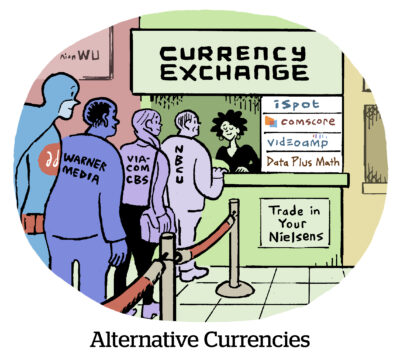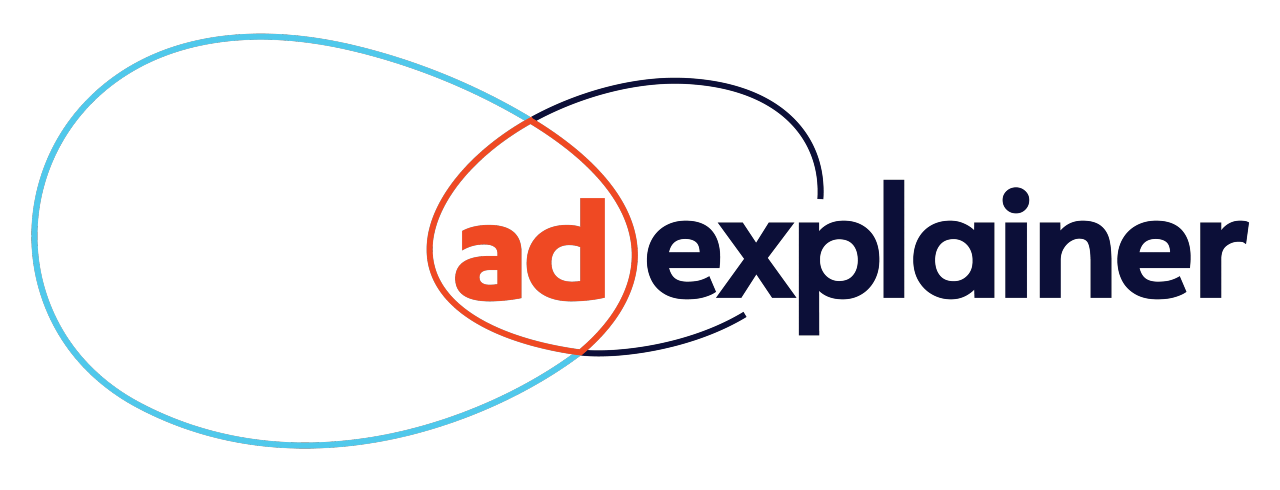
Agencies are busy gearing up to buy client campaigns on alt currency this upfront season.
This year will be the year of “massive change” for the industry, as it truly begins the process of using alt currencies for campaign buying, selling and measurement, said Brad Stockton, SVP of US national video innovation at Dentsu.
Nielsen just won back accreditation for its national ratings last month, but, at this point, the measurement currency ship has already sailed toward the horizon of big data and accuracy.
Luxottica, for example, is a decades-old brand that’s been using Nielsen as long as it’s been advertising on TV. But when Nielsen lost its accreditation, the brand started exploring other options.
Brands can no longer “throw money into the TV market and hope that it works,” Caroline Proto, director of global media at eyewear brand Luxottica, told AdExchanger.
And Nielsen going back on its big data promise right before this year’s upfronts “lit a fire” under the brand’s media team to transition even faster, Proto said.
After doing some testing with VideoAmp, Luxottica plans to officially start transacting on alt currencies later this year.
Embrace change …
Luxottica is far from the only brand that’s ready to try something new.
Wayfair is “assessing its options in the currency marketplace” and plans to transact upfront buys on VideoAmp this year, said Lauren Sutkowsi, head of TV marketing at Wayfair.
Agencies are making sure they can support the fresh influx of demand from clients for alt currencies.
The Ohio-based creative and media agency Empower Media, for example, is “actively evaluating alternatives for buying and validating media delivery in light of [Nielsen’s] questionable data validation and [uncertain] advancements in tracking viewership,” said Chief Investment Officer Cathy Shaffner.
… But keep your options open
Agencies and brands aren’t dumping Nielsen entirely, though. Nielsen is a very familiar business partner that sits on decades of audience viewership data.
The truth about alt currencies is that most buyers and sellers transacting on alt currencies are still also using Nielsen.
While Horizon Media will continue using Nielsen, for example, the agency also “understands the importance of vetting all possible currency and measurement solutions to give [advertiser] clients more choice,” said John Marson, SVP and managing director of Horizon.
After all, the point of the alt currency is partially to have more options, which include Nielsen.
“No one option or partner is off the table right now,” Shaffner said. Empower’s plan for the upfront is to use alt currencies as requested by clients and pair them with a “dual read” of audience delivery data from Nielsen and VideoAmp for measurement on all buys.
To “lay a firm foundation” for the future of TV currency, Shaffner said, agencies are in testing mode.
Currents of currency
Transitioning away from a century-long norm of TV transactions doesn’t happen overnight. They must be incorporated into existing business workflows for buyers and sellers.
“The plumbing is a really core element” to actually using alt currencies at scale, said Dentsu’s Stockton.
Getting backend systems ready to handle data from different currency – and multiple currencies at that – is a priority for programmers and agencies this year as opposed to last year, when the industry’s discussions about alternatives was “truly a measurement game versus a currency game,” Stockton said.
Last year, many agencies were still adapting to Nielsen alternatives as measurement solutions without necessarily using them as a basis of valuing media for transaction. This year, though, most agencies plan to use those alternatives as real currency.
Nuts and bolts
But first, agencies need to make sure their currency solutions “match” with their data strategies, Stockton said.
This next step in the buy side’s journey is to create standards for new video currencies, including how those currencies collect and process data. That’s exactly why a new joint industry committee (JIC) formed this year. And Paramount, one of the programmers behind the JIC, published a template to advise buyers and sellers on how to actually use those new currencies.
Omnicom Media Group (OMG), for example, is tapping VideoAmp because its data processing infrastructure is “best positioned to support OMG’s advanced TV strategy,” said Mariel Estrada, the agency’s head of video currency. OMG already integrated with VideoAmp for campaign planning, activation and measurement.
Still, like just about everyone else, OMG says it’s keeping its options open with “different flavors of interest among our client base,” Estrada said.
Hence why “multicurrency” is the new term du jour.
Can’t we all just get along?
Speaking of options, where does Nielsen actually fit into the picture?
Although Nielsen’s legacy panels are still a stepping stone for most brands, agencies and programmers, the industry expects Nielsen to prioritize its currency solutions with big data via Nielsen ONE to compete with the other options out there.
Luxottica, for one, expects Nielsen ONE to become a “potential option in the multicurrency future, rather than the legacy panel-based currency,” Luxottica’s Proto said.
The industry also wants Nielsen to join the JIC.
The JIC positions itself as an unbiased group creating standards to apply to all currency options for the sake of consistency, which is why the JIC wants Nielsen at the table, too, Dentsu’s Stockton said. But right now, there’s some serious tension between Nielsen and the JIC over fundamental disagreements, especially where MRC accreditation is concerned.
Lights, currency, action
A few weeks ago, Nielsen publicly refused to join the JIC, in part because the organization isn’t prioritizing MRC accreditation.
The JIC prefers that the currencies it certifies have accreditation, but it isn’t a requirement, because the urgency for using new currency is too great for the industry to wait around for a years-long process to wrap first.
Accreditation is “core” to viable currency solutions, Stockton said, but it takes a ton of time. So the JIC can’t just dismiss currencies that don’t have accreditation yet since most of them don’t – yet.
According to Stockton, the JIC requires the currencies it certifies to prove they’re in the accreditation process. (Dentsu is a part of the JIC.) And just saying you’re pursuing accreditation isn’t enough, Stockton added. Actually taking steps to get there is “imperative.”
VideoAmp, iSpot and Comscore all asserted their progress in securing MRC accreditation during a recent JIC summit.
Accreditation or not, buyers are moving ahead with their plans to transition to alt currencies.
Right now, advertisers need to “push [themselves] as much as possible” to test and use new currencies that can help their businesses achieve a higher return on ad spend, Proto said.






 By
By 




